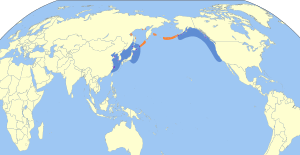Ancient murrelet facts for kids
Quick facts for kids Ancient murrelet |
|
|---|---|
 |
|
| Conservation status | |
| Scientific classification | |
| Genus: |
Synthliboramphus
|
| Species: |
antiquus
|
| Subspecies | |
|
|
 |
|
The ancient murrelet (Synthliboramphus antiquus) is a small bird that belongs to the auk family. Its scientific name, Synthliboramphus antiquus, comes from Ancient Greek and Latin words. Synthlibo means "to compress," and rhamphos means "bill," referring to its beak. The word antiquus is Latin for "ancient."
These birds are called "ancient" because of a special grey pattern on their back. It looks a bit like a shawl worn by older people. The English word "murrelet" is a smaller version of "murre," which might come from the sound of a Common murre.
Contents
What Does It Look Like?
This small auk has a black head, throat, and the back of its neck. Its back is grey, and its belly is white. It has a short, yellow, and stubby beak. Its tail is small, black, and rounded.
In summer, adult ancient murrelets have white streaks on their heads. These streaks make them look a bit old, which is another reason for their name. Young birds or adults in other seasons look similar, but they do not have these white streaks or the black throat.
Ancient murrelets fly with quick wing beats because their wings are short. They often tilt from side to side more than other small auks when flying.
Measurements:
- Length: 20-24 cm (7.9-9.4 inches)
- Weight: 153-250 grams (5.4-8.8 ounces)
- Wingspan: 45-46 cm (17.7-18.1 inches)
Types of Ancient Murrelets
Scientists have found two main types, or subspecies, of the ancient murrelet:
- S. a. antiquus: This type lives in northeast Asia, the Aleutian Islands, and western Canada.
- S. a. microrhynchos: This type is found around the Commander Islands in eastern Russia.
Where They Live and Travel
Ancient murrelets build their nests in colonies on islands. They breed in places like the Yellow Sea (near China), along the Russian Pacific coast, the Aleutian Islands, and the Haida Gwaii islands in British Columbia. About half of all ancient murrelets in the world breed in Haida Gwaii.
Some ancient murrelets are amazing travelers! They migrate about 8,000 kilometers (5,000 miles) from Canada to spend winter near Japan and China. This is the only bird known to cross the entire North Pacific Ocean. They start their journey back in February, flying for four or five hours each day. Scientists believe these birds originally came from Asia. Their long migration takes them back to their ancient homeland.
Other ancient murrelets fly south for the winter to places like California. Sometimes, autumn storms can carry them far inland in North America. A very surprising sighting happened in 1990. An ancient murrelet was found on Lundy island in England! Even more amazing, the same bird seemed to return to this British island for the next two springs.
How They Live
What They Eat
Like other auks, ancient murrelets dive and swim underwater to find their food. They use their wings to push themselves through the water. We don't know everything about their diet. In winter, they mostly eat small crustaceans, which are like tiny crabs or shrimp. In summer, they eat both small fish and crustaceans. In Haida Gwaii, they seem to eat mostly small fish that live deep in the ocean.
How They Raise Their Young

Ancient murrelets nest in large groups on islands in the North Pacific. They dig burrows in the forest soil, often among tree roots, under logs, or in grassy clumps. Sometimes, they use cracks in rocks. They usually lay two eggs, but sometimes just one.
These birds arrive at and leave their nesting areas at night. This helps them avoid predators. For the same reason, the young chicks are never fed at the nest. Instead, they leave the burrow and head to the sea just 1 to 3 days after hatching. The parents and chicks recognize each other by their calls. Once the chicks reach the sea, they find their parents by calling out. The whole family then swims away from land, usually at night. They will travel a long distance, often up to 50 kilometers (30 miles), for at least twelve hours. After this journey, the parents feed the young only at sea for more than a month. This bird spends less time on land than almost any other bird!
Protecting Ancient Murrelets
The ancient murrelet is listed as a species of 'Special Concern' in Canada. This means their numbers have dropped a lot over the last century. This is mainly because of predators like rats. These rats were brought to the breeding islands by ships in the 1800s. For example, on one island, there used to be 200,000 breeding pairs. After rats arrived, that number dropped to about 14,000 pairs in the 21st century.
In 2009, a project called "Night Birds Returning" started. It aimed to help the murrelet population grow again by getting rid of rats on the islands in Gwaii Haanas National Park Reserve and Haida Heritage Site. To succeed, every single rat needs to be removed. Just one pregnant rat can repopulate an island in a year or two. In 2011, they started removing rats from the ground on two islands. Later, in 2013, they used poisoned pellets dropped from the air on other islands. These pellets were designed to attract only rats. After the rats are removed, the area needs to be watched for two years to make sure it is truly rat-free.
See also
 In Spanish: Mérgulo antiguo para niños
In Spanish: Mérgulo antiguo para niños


